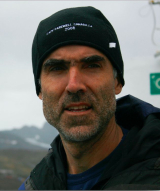High latitude climate and climate variability
Professor in the Department of Atmospheric and Oceanic Sciences
Office: Burnside Hall 823
Tel.: (514) 398-4369
Fax.: (514) 398-6115
bruno.tremblay [at] mcgill.ca (E-mail)
Research interests
I am interested in the high latitudes and their effect on global climate, local climate and lower latitudes. My research is centered on sea ice at the interface between the ocean and the atmosphere. The Arctic is transitioning from a perennial to a seasonal ice cover; this is often referred to as the Antarctification of the Arctic Ocean. In my group, we study the impact of lateral and vertical ocean heat flux, surface radiative and turbulent fluxes, meridional moisture and heat transport and cloud type on the observed decline of sea ice. In addition to decadal projections of Arctic sea ice, I am interested in seasonal and sub-seasonal forecast of sea ice conditions. To this end, we use Global Climate Models (GCMs), coupled primitive equations ice-ocean models, and stand alone sea ice models. I also do field work in the Canadian Arctic and Labrador coast to study the sea ice mass balance and internal sea ice stresses. Finally, I am interested in the development of new sea ice rheological model (stress strain relationship) and the applications of new numerical techniques to solve for the highly non-linear momentum equation of sea ice.
Outstanding questions
- What is responsible for rapid sea ice decline in the Arctic Ocean?
- How will these changes impact the fresh water and heat budget of the Arctic? The fresh water exchange between the Arctic and the northern North Atlantic where deep convection is present? And vertical mixing of heat, salt and nutrient in the Arctic?
- What are potential sources of predictability of Arctic sea ice on sub-seasonal, seasonal and decadal time scale?
- How will negative feedbacks associated (for instance) with the potential increase in summer cloud cover and fresh water flux to the northern North Atlantic affect the response of the high latitude to this warming?
- What are the geophysical mechanical strength properties of sea ice?
Current projects
- The study of the fresh water and heat budget of the Arctic Ocean and its effect on the density driven ocean circulation and meridional ocean heat fluxes in the Arctic Ocean. This work is done using the Community Earth System Model Large Ensemble, in collaborations with Alexandra Jahn (Colorado State University) and Marika Holland (NCAR) on the modeling side, and Peter Schlosser and Robert Newton from the Lamont Doherty Earth Observatory (LDEO) of Columbia University (CU) on the observational side.
- We use the paleo-record to constrain future projections of Arctic Climate Change. To this end, we consider the Mid Holocene Climatic Optimum as a proxy for future climate change in the Arctic. We identify GCMs that are sensitive to the increase summer solar insolation during the Mid Holocene Climate Optimum as suggested by paleo-proxy data and assess whether those same models are more sensitive to increase longwave radiative forcing associated with greenhouse gas.
- Development of new sea ice rheological models and the energetics of sea ice. This work is done in collaboration with Martin Losch from the Alfred Wegener Institute and Jean-François Lemieux from Environment and Climate Change Canada (ECCC).
- Development of new numerical solver using preconditioned Krylov methods.
- Rapid sea ice decline in the Arctic Ocean and its relationship with lateral ocean heat fluxes through the Bering Strait, Fram Strait and the Barents Sea Opening, vertical ocean heat flux associated with Ekman pumping along active sea ice leads, and surface turbulent and radiative fluxes at the ice surface.
- The effects of inertial oscillations on air-sea interactions, internal wave generation and vertical ocean mixing in ice-covered seas. This work is done in collaboration David Straub and Luc Rainville from the Applied Physics Laboratory – UW.
- Lagrangian study of pollutant, sediment and nutrients transport by Arctic sea ice. This work is done in collaboration with Stephanie Pfirman (University of Arizona) and Robert Newton (LDEO).
- Seasonal forecasting of sea ice using a Lagrangian Trajectory model. This work is done in collaboration with Bill Merryfield and Bertrand Denis (ECCC), Robert Newton (LDEO) and Stephanie Pfirman (University of Arizona).
- The impact of the low-level temperature inversion on the surface radiative balance in the Arctic Ocean. This work is done in collaboration with Jen Kay (Colorado State University).
- Ice stress and ice mass balance data analysis for the development of new sea ice dynamic models including thermal stress. This study is done in collaboration with Adrienne Tivy (Canadian Ice Service) and Jean-François Lemieux (ECCC).
- The study of sea ice arches using a linear elastic solid model. Derivation of sea ice mechanical properties of sea ice using this linear elastic solid model and satellite observations.
Some recent publications
- Ungermann, M., L.B. Tremblay, T. Martin, M. Losch, 2017: Impact of the ice strength formulation on the performance of a sea ice thickness distribution model in the Arctic, Journal of Geophysical Research, Oceans, Vol. 122, doi: 10.1002/2016JC012128.
- Bouchat, A., L.B. Tremblay, 2017: Using sea-ice deformation fields to constrain mechanical strength parameters of geophysical sea ice, Journal of Geophysical Research, Oceans, Vol. 122, doi: 10.1002/2017JC013020.
- Auclair, J.P., J.F. Lemieux, L.B. Tremblay, H. Ritchie, 2017: Implementation of Newton's method with an analytical Jacobian for solving the sea ice momentum equation: an investigation in 1D, Journal Of Computational Physics, Vol. 340, page 69-90.
- Newton R., S. Pfirman, L.B. Tremblay, P. DeRepentigny, Increasing Transnational Sea Ice Exchange in a Changing Arctic Ocean, Earth's Future, Arpil, doi: 10.1002/2016EF000500.
- Williams, J., L.B. Tremblay, J.-F. Lemieux, 2017: The effects of plastic waves on the numerical convergence of the viscous–plastic and elastic–viscous–plastic sea-ice models, Journal of Computational Physics, Volume 340, Pages 519-533, ISSN 0021-9991, doi:10.1016/j.jcp.2017.03.048.
- Blanken, H., L.B. Tremblay, S. Gaskin, A. Slavin, 2017: Modelling the long-term evolution of worst-case Arctic oil spills, Marine Pollution Bulletin, Volume 116, Pages 315-331, ISSN 0025-326X.
For a complete list of publications, please visit our publications page.